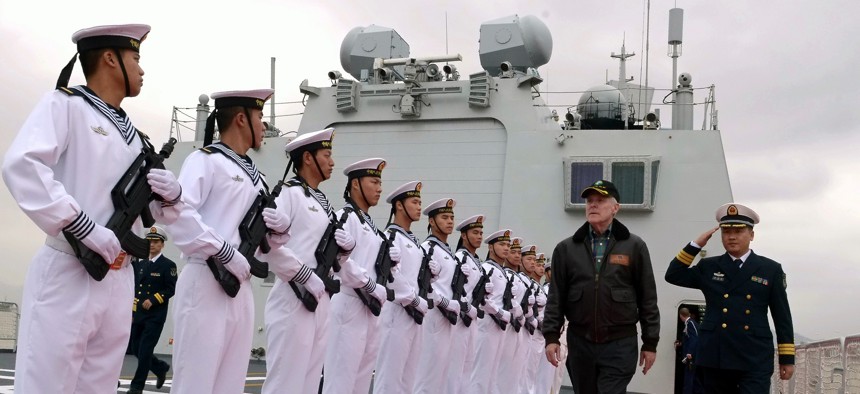
Chinese sailors render honors to Secretary of the Navy (SECNAV) the Honorable Ray Mabus during a visit to the People's Liberation Army Navy hospital ship Peace Ark. U.S. Navy photo by Chief Mass Communication Specialist Sam Shavers/AP
Here’s One Way the US-China Relationship Is Improving
Even as tensions in the South China Sea heats up and online thefts increase, military-to-military contacts have been rising for five straight years.
There’s plenty of friction between the U.S. and China these days, but at least one aspect of the relationship hasn’t been this strong since the 20th century. Military-to-military contacts — from low-level exercises all the way up to presidential and four-star visits — have been shooting up since 2010, and are on pace to reach historic highs.
In the past, mil-to-mil contacts have been among the first ties severed when things went south between Washington and Beijing. So what’s behind the recent sustained momentum? And how will the mil-to-mil relationship help shape the course of national security?
Few Historical Precedents
A normal military relationship with an ally encompasses everything from meetings with top officials and commanders to educational exchanges to military exercises. Even avowed enemies can work together; the U.S. and the Soviet Union maintained extensive military-to-military relations even at its height of the Cold War. But the relationship with China is something new: a superpower interacting with a regionally influential great power with global aspirations.
“There are not many relationships that have some historical precedent like we have with China today,” said Roy Kamphausen, senior vice president for research at the National Bureau of Asian Research and a former Pentagon staffer who has worked extensively on Chinese security policy. “What makes it unique is the ties and nature of the political system, and some bad history between us that has led to a lack of strategic trust. When you put those two together, that sort of contributes to why people leap to looking at the unique aspect of the U.S.-China relationship.”
U.S. officials view military-to-military contacts as a path to relationships and understanding that can help ward off miscalculation and war. A senior defense official said the military’s “approach to China and the region is based on enduring interests and established institutional relationships and mechanisms, creating stability in the relationship at leadership-levels, working-levels as well as between operators of ships and aircraft.”
The U.S. has also tried to use such contacts to goad Beijing toward transparency and guide its arrival as a world leader. “Obviously, China is a rising power, and we need to work to recognize that and manage its rise within the international system,” said James Miller, who served as U.S. defense undersecretary for policy in 2012 and 2013.
As for China, it has long seemed to regard mil-to-mil contacts less as a tool and more as a signal. Beijing switched contacts on and off depending on the state of diplomatic relations, said Joseph Prueher, a retired admiral who led U.S. Pacific Command and served as ambassador to China. When relations were warm, as in in the late 1990s, military contacts were relatively robust and extensive. When they chilled — after U.S forces accidentally bombed the Chinese embassy in Belgrade in 1999, or after the 2001 collision with a Chinese fighter jet that downed a Navy intelligence plane on Hainan Island — mil-to-mil contacts were among the first to be cut off.
.png)
Prueher said the mil-to-mil relationship is further complicated by its relatively top-heavy nature. A good chunk of the contacts are between very senior U.S. and Chinese officials, while lower-level bonds haven’t quite developed yet.
“In countries where you have a depth of military-to-military relationships, you have junior officers who have grown up together, they have known each other for 15 years, they have been to schools together, they’ve grown up with personal relationships that enhance the straight military relationships,” Prueher said. “And of course, in China, these personal relationships transcend any sort of formal agreements you might have. These personal relationships are more important than the formal agreements.” But, he said, “We don’t have the amalgam that holds it together at the lower level.”
But even the higher-level relationships remain shallow. China’s “stratified and very centralized decision-making process” keeps its military officers and officials from doing the kind of exchanges that build trust, said Wallace “Chip” Gregson, a retired Marine three-star who served as assistant defense secretary for Asian and Pacific Security Affairs from 2009 to 2011.
Nor is there much time to build such relationships, thanks to the U.S. practice of shuffling officials — from the Defense Secretary on down — in and out of office every two to three years. Ralph Jodice, a retired Air Force lieutenant general who served as the U.S. defense attache to China from 2004 to 2007, said Chinese officials had explained to him how they saw their foreign relationships: pengyou, hao pengyou, and lao pengyou — friend, good friend and old friend. The first time a U.S. official visited, they were a pengyou; the second time they were hao pengyou, and the third time they were lao pengyou. The Chinese officials would say that one needed to become an old friend before substantive policy change could happen.
“But then they would turn to the PACOM commander and say, ‘You normally only serve as the PACOM commander for maybe 2 years, maybe 3 years, and we might only see you once or twice, so it’s difficult to become old friends,’” Jodice said. “Quantity has a certain quality of its own.”
There are other obstacles to an easy relationship. In 2000, Congress outlawed mil-to-mil contacts that might create a national security risk by exposing critical information. U.S. officials routinely bemoan a lack of transparency and reciprocity in exchanges, and an overly staged feel to mutual visits. Then there are the increasing points of friction between the countries: U.S. weapons sales and gestures of support for Taiwan, network breaches and data theft, even air and sea operations that bring U.S. and Chinese forces into proximity.
Right now, the U.S. and China work together in several areas, including counterpiracy and counterterrorism missions in the Gulf of Aden. Chinese military officials also pay regular visits to U.S. military educational institutions, like the February visit that brought to the National Defense University a 12-person delegation led by Rear Adm. Li Ji, the head of the Ministry of National Defense Foreign Affairs. A senior defense official said that the mil-to-mil relationship has “sustained positive momentum over the past few years, deepening bilateral engagements and making progress developing risk reduction measures.”
The two militaries have also worked alongside each other in humanitarian assistance exercises, but haven’t really cooperated extensively in them. Gregson says that he doesn’t “sense any willingness from the Chinese to increase their level of participation.”
Many in Congress are dubious about such contacts as well. “Most people on Capitol Hill believe the Chinese get a whole lot more out of it than we do,” said Rep. Randy Forbes, R-Va., who has worked extensively on China policy.
In Forbes’ estimation, the Pentagon has too long tried to build a relationship by hosting Chinese delegations, visits that produced little in return. Over the past year, he has tried to persuade then-Defense Secretary Chuck Hagel and others to step back and assess what exactly the U.S. is getting for their efforts. “You have a lot of people at the Pentagon that just start saying, ‘The more contact we have, the better it is,” Forbes said. “We always have to have metrics to measure whether our policies are working, and you can’t have a metric to measure if its working if you don’t know what the policy is.”
The Ultimate Question
Still, senior U.S. military leaders appear resolved to nurture the mil-to-mil relationship. In May, David Shear, U.S. assistant defense secretary for Asian and Pacific security affairs, criticized China’s activities in the East and South China Seas. But he also said the administration wants to “build transparency and improve understanding with China through mil-to-mil ties.” Last month, Adm. Harry Harris, who leads U.S. Pacific Command, charged China with establishing military posts on its artificially expanded reefs, yet added that he wants his command to foster the relationship with the Chinese military.
That’s in large part because the countries themselves are becoming more and more intertwined. As the U.S. continues its turn towards the Asia-Pacific, bringing two nuclear-armed powers in closer contact with each other, the military-to-military relationship is becoming more important than ever.
“The question of whether war is inevitable is at the base of this,” said Miller, the former policy chief. “This administration in particular has made the calculation that it’s not inevitable, but it's possible, and we want to both work with the Chinese, and at the same time approach that work with them from a position of strong alliances and strong military and other capabilities.”
Beyond the bilateral relationship, the U.S. will need China’s help as transnational threats such as the Islamic State continue to metastasize. Pentagon planners also want the Chinese military’s aid in humanitarian and disaster-response missions.
Here’s the ultimate question: can a mil-to-mil relationship help a crisis from becoming a war?
“Put it this way, it can’t be done by a military commander somewhere out there in the Pacific,” Gregson said. “You’re not going to do a military-to-military discussion in the middle of a crisis...I see no circumstances where a senior military officer on the Chinese side could do that without risking their position or worse.”
Still, policymakers should adopt the stance that mil-to-mil ties are a normal, healthy activity between governments, even ones at odds, Kamphausen says. “Things we ought to get done together ought to serve both interests, as well as international security goals.”
NEXT STORY: An Iran-Deal Skeptic Becomes a Supporter




